In Belgium, we stopped in
Marche-en-Famenne for supplies and found much more Art than we realized was there. In addition to the violins:
 |
| Les violons by Luc Templier, Silvia Bauer, Jean-Pierre Hallet, Jean Lanners et Lise Ricaille. 2014 |
And other local sculpture (just a few):
 |
| La Boîte de Jazz by Catherine Lhoir, 2019 |
 |
| Loin' by Jean-Michel Folon, 1994 |
 |
| The Three Graces by Louis Noel |
There was an exhibition of
K-Dolls all along the main street of the city. A project of the local Kiwaniis to raise money to buy and distribute rag-dolls to sick children. They also made them in a much smaller size for exhibition and sale.
This area is considered the gateway to the
Ardenne and it is a very nice part of
Wallonia. We were back in the region to see the latest additions to the
Sentiers d'Art en Condroz-Famenne project. Seventeen new works (to go with the ten works installed in 2017 and the fifteen works of 2018) for a total of forty-two works of art in nature, including seven artistic shelters, on a 141 km Art Trail.
And the countryside is gorgeous. It's not always easy to find them while driving from place to place, but here are a few of the ones we did:
 |
| Human Nature by Luiza Rauleac and Anata Roosens, 2019 |
 |
| Fondue by Fiona Paterson, 2019 |
 |
| Pose inclinee by Natacha Brion and Anne-Sophie de Visscher, 2019 |
 |
| Farakas 4 by Marc Averly, 2019 |
 |
| Recompose by Elcaro, 2019 |
 |
| Morpho by Isabelle Aubry, 2019 |
 |
| Woven Shelter by Tim Norris, 2019 |
 |
| Torvtak by Mario Boccolini, 2019 |
We had an unexpected surprise in the town of
Waha, just outside Marche-en-Famenne. It is the
Église de Saint-Étienne which features glass windows by Belgian artists
Jean-Michael Folon. Completed in 2004-5, the six windows describe scenes from the legend of Saint Stephen.
Oh, just a few more pictures from March-en-Femenne:
 |
| Castaldie by Louis Noel |
One day, Marie went with the family of our hosts to visit the The Caves of Han-sur-Lesse, a major tourist attraction located on the outskirts of the village of Han-sur-Lesse. The kids were adorable and, she said, the caves were delightful.
Nancy, in the province of Lorraine, France, was to be our base for Bastille Day weekend. The enormous
Place Stanislaus was filling with visitors when we arrived, but there were no major celebrations that we could find.
We began at the nearby
Musée des Beaux-Arts, one of the oldest in France. So many wonderful paintings and sculptures, I will, as usual, highlight mostly women artists whose work hangs in the museum.
 |
| Portraits by Marie-Anne Collot-Falconet,1767-1773 |
 |
| Anne et Jehanne by Laura Leroux-Revault, c1894 |
 |
| Portrait of Elise Voiart by Constance Meyer, 1811 |
 |
| Portrait de Guilbert de Pixerecourt by Sophie Bertraud-Cheradame, 1822 |
 |
| Le Lancement du filet by Suzanne Valadon, 1914 |
 |
| La Citadelle by Simone Boisecq, 1956 |
 |
| Fête de Nuit by Theophile-Alexandre Steilen, 1900 |
 |
| L'application a la decoration des brodeuses au metier et a l'aiguille by Theophile-Alexandre Steinlen, c 1900 |
 |
| Torso Agenouille by Ossip Zadkine, 1927 |
Nancy was one of the centers of the Art Nouveau movement and the
Musée de l'École de Nancy is devoted to the "school" founded here in 1901 by
Émile Gallé,
Victor Prouvé,
Louis Majorelle,
Antonin Daum and
Eugène Vallin. The museum, opened in 1964, is set in the former house of a patron of the
École de Nancy, Eugène Corbin.
 |
| by Jacques Gruber, c 1904 |
 |
| Main aux Algues et les coquillages by Émile Gallé , 1904 |
There were many stylish neighborhoods for us to explore. Here are a few of the Nouveau villas:
 |
| rue Félix-Faure |
 |
| Les Glycines for Charles Fernbach by François-Émile André, 1903 |
 |
| from Fantasy House by François-Émile André |
And here are slices of Nouveau from around town.
Well, it was 14 juillet, so we walked over to the Porte Désilles for the ceremonies.
Just a few more shots from Nancy:
We left Nancy, and Lorraine province for
Alsace. They used to be connected, but the Alsace has a long story in both French and German history. So it was not a surprise that our first stop was in
Soultzmatt. Not a very French-sounding name. But a beautiful place with gentle hills covered in vineyards. And in town they produce outstanding Alsatian wine
The next week was spent soaking in the Alsatian culture as we cruised up and down the valley, visiting colorful medieval towns, such as
Kaysersberg,
Ammerschwihr,
Riquewihr,
Zellenberg,
Mittelwihr,
Chatenois, and others. The "art" we found was mostly incidental.
 |
Flammekueche or tarte flambée
|
 |
| Kaysersberg |
 |
| Ammerschwihr |
 |
| Morrigan by Frederic Maroselli, 2014 (Riquewihr) |
 |
| Riquewihr |
 |
| Add caption |
When we got to
La Maison de la Choucroute, in
Meistratzheim, we found that there were no tours that day. They have been making sauerkraut for five generations and you could smell it in the air.
We were not completely art-free, however.
Colmar, the largest city in the region, beckoned. Like the villages and towns here, Colmar has lots of colorful and interesting Medieval buildings and towers. There is an area called “Little Venice” due to a couple of canals, with lots of streets and alleys to walk down and make discoveries.
 |
| Janus and the Unicorn by Andreas Edzard and Laurent Hunzinger, 2005 |
Synonymous with Alsace folklore is the artist known as
Uncle Hansi. His real names was Jean-Jacques Waltz (1873-1951) and was born in Colmar. Famous for his quaint drawings, some contained harsh critiques of the Germans, and Hansi became a national hero of both the First and Second World Wars.
 |
| La Marseillailes by Hansi, 1915 |
 |
| La Bataille de la Marne by Hansi, 1915 |
He was also well-known for designing signs for businesses from the Alsace to Paris. We stopped in at the
Village of Hansi and his Museum. While a very commercial operation, we enjoyed learning about Hansi and seeing his work.
Colmar was also the birthplace of Statue of Liberty (
Liberty Enlightening the World) creator,
Frederic Auguste Bartholdi.
One of our best discoveries was made fifteen kilometers west of town in
Neuf-Brisach, where a former Vauban fortification (UNESCO site) has been transformed into a work of Art, more than the museum of Urban and Street Art it is. Just one year old,
Musee d'Art Urbain et de Street Art, the idea of
Stanislas Belhomme, has already included more than twenty international artists.
Finally, just a few more shots from Colmar:
Our art drought ended with an excursion across the border to
Basel, Switzerland. We were there to visit with Marie's cousin and family, but as long as we were there…
The
Kunstmuseum Basel was so vast (the largest in Switzerland), we explored the old building in the morning, and then after lunch with the relatives, we drove back to see the new building, across the street.
This one opened in 2016, however, the roots of the museum go back to 1661 when a collection of works by Hans Holbein was purchased by the city of Basel, which made it the first municipally owned and therefore open to the public museum in the world. Lots of Swiss artists such as
Hodler,
Klee, and
Cuno Amiet:
 |
| View into Infinity by Ferdinand Hodler, 1914-16 |
 |
| Apple Harvest by Cuno Amiet, 1913 |
 |
| Jungle with Setting Sun by Henri Rousseau, 1910 |
 |
| Illuminated Windows II by Lyonel Feininger, 1932 |
 |
| Sirene by Odilon Redon, c1900 |
 |
| Venus, injured by Diomedes, returns to Olympus by Jean-August-Dominque Ingres, c1803 |
And way too many artworks to include here, so
CLICK HERE TO SEE MORE.
But just a few more shots...
It was now time to move to north Alsace and the legendary,
Strasbourg. This queen of half-timbered buildings with beautiful waterways, off the Rhine, is one of the most important cities in Europe. In addition to being home to the European Parliament, making it a major place in the European Union. With its cathedral and ancient center, Strasbourg was the first city center to receive the UNESCO designation.
We were there for
Les Confréries Viniques d'Alsace. Followers may recall that we went to the
Journée des Confréries at the Maredsous Abbaye in Belgium, last year. There, in addition to the procession of brotherhoods, was a great festival with tents offering a wonderful assortment of refreshments, entertainments and things to see. For the event in Salsbourg, after posing in front of the church, they had a short parade and then went off to their own private party. Still fun.
Afterwards we visited
La Musée d'Art Moderne et Contemporain, on Place Hans-Jean Arp, who was born in Strasbourg. In great contrast to the old city, this museum, as the name clearly says, has Modern and Contemporary. From lots of
Victor Brauner and rooms of
Kandinsky to great galleries of stuff I wasn't into.
 |
| Birthplace of Jean Arp |
 |
| La Musée d'Art Moderne et Contemporain |
 |
| La Parole by Victor Brauner, 1938 |
 |
| La Loge by Lou (Louise)-Albert Lasard, c1919 |
 |
| Basse-cour by Natalia Gontcharova, 1907-09. |
 |
| self-potrait by Lisa Elisabeth Krugell, 1947 |
 |
| Elizabeth (Nana) by Niki de Saint Phalle, 1965 |
Strasbourg also has its share of Art Nouveau gems:
And a few more shots from Strasbourg.
 |
| Ligne indéterminée by Bernar Venet, 1990 |
 |
| Envol by Jivco, 2011 |
And then it was time to leave Alsace and drive west to Paris. But, let's save that for PART 3.




























































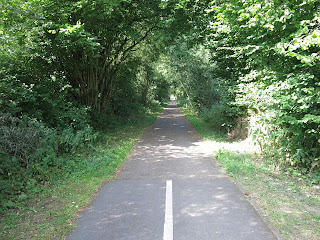




































































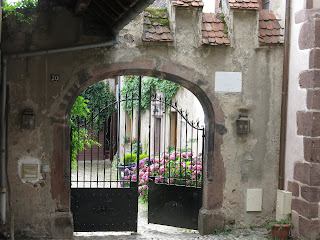
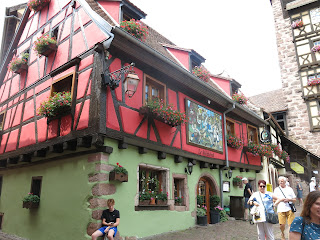





























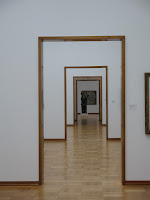








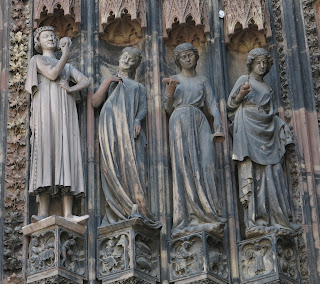















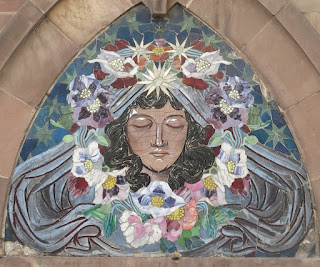












No comments:
Post a Comment